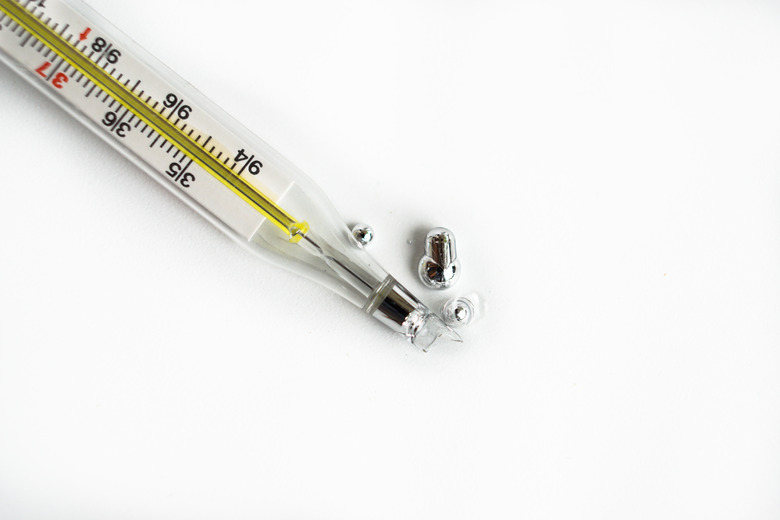How To Dispose Of A Mercury Thermometer
We may receive a commission on purchases made from links.
In the early 1700s, when physicist Daniel Gabriel Fahrenheit was experimenting with his version of the thermometer, mercury made an ideal liquid component for the device because it would quickly expand or contract in reaction to fluctuating temperatures. Three hundred years later, we know that exposure to mercury can cause serious neurological damage. Thermometers for home use are no longer made with mercury, but older versions may still be rattling around in the back of medicine cabinets or may be tucked into first-aid kits. It's not safe to throw one of these thermometers in the trash, where it can break and create mercury exposure, so always use caution when disposing of old glass thermometers.
Identifying a Mercury Thermometer
Identifying a Mercury Thermometer
Only mercury thermometers require special end-of-life handling; alcohol thermometers and digital thermometers can generally just be thrown in the garbage. If you're not sure whether you have a mercury thermometer or alcohol thermometer, look closely at the narrow tube in the middle of the device. It's probably an alcohol thermometer if the liquid inside the thermometer is blue or red. It may be a mercury thermometer if this tube is filled with silvery fluid.
At least one manufacturer does make a glass thermometer containing a silver liquid that isn't mercury, but these thermometers should be clearly labeled as mercury-free. If your thermometer contains silver liquid and you're not sure what it is, play it safe by assuming it's mercury and take the proper steps to dispose of the thermometer.
Disposing of an Intact Mercury Thermometer
Disposing of an Intact Mercury Thermometer
A mercury thermometer is safe to handle as long as it's intact. Generally, municipal agencies that manage waste removal will have clear procedures about how and where they accept items containing mercury. Sometimes, consumers will be asked to drop off their mercury-containing devices at waste collection sites during special events. In other cases, municipalities will accept these devices during operating hours at a designated drop-off site.
To find specific guidance about where to dispose of your intact mercury thermometers, contact your municipal solid waste agency or do an online search using your town or city name plus the words "mercury disposal." Earth911's searchable recycling database may also be useful.
Disposing of a Broken Mercury Thermometer
Disposing of a Broken Mercury Thermometer
If an old mercury thermometer breaks, cleanup and disposal become a little more complicated. It's easy to tell when you've spilled mercury because the substance will form small silver beads that look like tiny ball bearings. Exposure to mercury vapor can be dangerous, so exercise extreme caution while cleaning up the pieces. Immediately clear children and pets out of the area as well as anyone else who doesn't need to be there. Pregnant women should never be close to spilled mercury, as significant exposure can cause birth defects.
Always wear protective rubber gloves before starting mercury cleanup. If the spill happened on a hard surface, like wood or tile, use a piece of cardboard to carefully nudge all the spilled mercury beads together into one larger ball. Collect the beads with an eyedropper and squeeze them onto a damp paper towel or use two pieces of cardboard to scoop the mercury onto the paper towel.
With the gloves still on, place the paper towel in a zip-locking food storage bag. If any visible mercury remains on the floor, roll tape around your gloved fingers sticky-side out and use it to collect any remnants. Add the tape to the bag and seal it. Label the sealed bag with something like "broken mercury thermometer." Contact your municipal hazardous waste department or health department for disposal instructions. If mercury spills on a carpet or fabric surface, it can't be safely salvaged. Cut out the carpet where the mercury has spilled, seal the carpet in a garbage bag and dispose of it in the same way you dispose of the broken thermometer.
References
- United States Environmental Protection Agency: Storing, Transporting and Disposing of Mercury
- Utah Department of Environmental Quality: Disposal of Thermometers That Contain Mercury
- United States Environmental Protection Agency: What To Do If a Mercury Thermometer Breaks
- Earth911: Searchable Recycling Database
- Britannica: Thermometer
